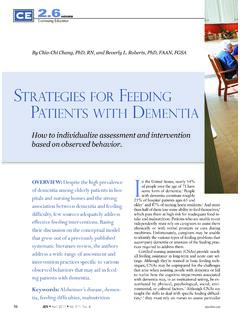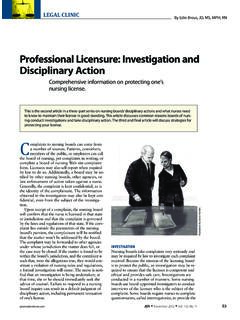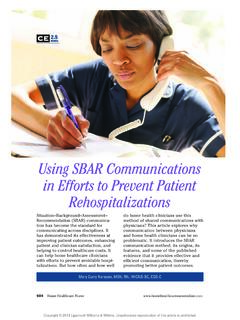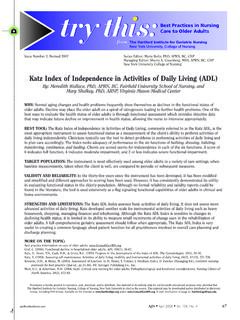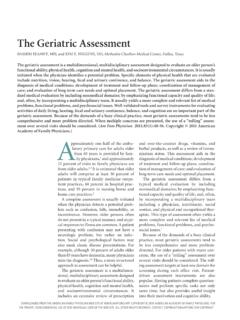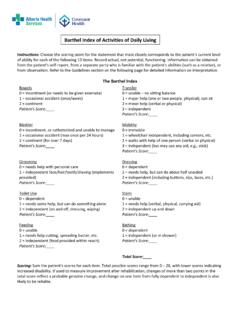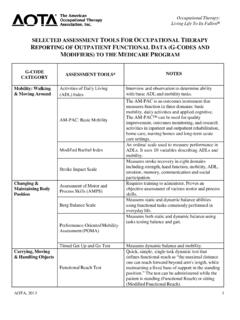Transcription of How To By Carla Graf, MS, RN, CNS-BC The ... - CEConnection
1 How To HOURS. try this Continuing Education By Carla Graf, MS, RN, CNS-BC . The Lawton Instrumental activities of daily living Scale By detecting early functional decline, the scale can help nurses with discharge planning. Ed Eckstein 52 AJN April 2008 Vol. 108, No. 4 read it watch it try it Overview: Acute illness or a worsening chronic condition can hasten functional decline in older adults. During hospitalization, reduced mobility and Web Video other factors may rapidly decrease an older Watch a video demonstrating the use and interpretation of the Lawton Instrumental patient's ability to perform activities crucial for inde- activities of daily living Scale at http://.
2 Pendent living , and the effects might be permanent. The Lawton Instrumental activities of daily living (IADL) Scale assesses a person's ability to perform A Closer Look tasks such as using a telephone, doing laundry, and Get more information on why nurses should handling finances. Measuring eight domains, it can assess for functional decline. be administered in 10 to 15 minutes. The scale may provide an early warning of functional decline Try This: Lawton Instrumental or signal the need for further assessment. For a free activities of daily living Scale online video demonstrating use of this assessment, This is the scale in its original form.
3 Go to See page 59. G. eorgia Koppel is an 81-year-old widow Lawton and Brody in 1969 to assess the more com- brought to the ED by neighbors who plex ADLs necessary for living in the found her in her yard, wandering and Competence in skills such as shopping, cooking, and disoriented. (This case is a composite managing finances is required for independent liv- based on my experience.) They reported ing. Because IADL function is usually lost before that Ms. Koppel had a noisy cough and mild confu- ADL function (such as bathing, eating, and using sion earlier in the week.)
4 Physical examination and a the toilet), assessment of IADLs may identify incip- chest X-ray show dehydration and pneumonia. A ient decline physical, cognitive, or both in an Foley catheter is inserted and her urine is dark older adult who might otherwise appear capable amber. Her mucous membranes are dry. Anxious, and restless, and oriented only to self, Ms. Koppel can't The Lawton IADL scale takes 10 to 15 minutes to provide a history. Her neighbors say that she lives administer and contains eight items, with a summary alone and has no children; they are unsure whether score from 0 (low function) to 8 (high function).
5 (See she has any living relatives. The Lawton Instrumental activities of daily living Ms. Koppel is hospitalized; iv fluids, antibiotics, Scale, page 60.) Each ability measured by the scale and oxygen are ordered. To begin planning for hos- relies on either cognitive or physical function, though pital care and for discharge, the nurse attempts to all require some degree of For example, a ret- perform a functional assessment. She asks Ms. rospective analysis by Cromwell and colleagues Koppel about her ability to perform activities of demonstrated an association between dependence in daily living (ADLs) such as grooming, eating, and three items on the scale (using the telephone, self- using the toilet and instrumental activities of daily medicating, and managing finances) and reduced cog- living (IADLs) such as managing her finances and nitive function in community-dwelling older adults arranging transportation.
6 However, Ms. Koppel is who hadn't been previously diagnosed with disoriented and cannot respond to questions, so the Low scores on other activities , such as nurse defers the assessment. housekeeping (a broad category encompassing simple tasks such as washing dishes or mowing the lawn), THE LAWTON IADL SCALE may more obviously point to problems in physical Functional assessment instruments measure ADLs function. and IADLs (see Table 1, page 55). Some also focus The scale can be administered with a written specifically on mobility, a crucial aspect of adult inde- questionnaire or by interview.
7 The patient or a pendence that is necessary for many ADLs and knowledgeable family member or caregiver may The Lawton IADL scale was developed by provide answers. It is appropriate for use with older AJN April 2008 Vol. 108, No. 4 53. How To try this Why Assess for Functional Decline? unctional decline in older adults often begins Despite the Joint Commission's mandates for F within 48 hours of hospital admission6 and may lead to disability, institutionalization, and death. In a assessment of functional status upon admission and throughout the hospital stay,13 acute care hospitals study of over 1,250 adults age 70 or older hospital- use no standard criteria to identify patients at risk for ized for acute illness, Sager and colleagues found functional decline.
8 Functional assessment screening . that 32% had declined in their ability to perform one using tools such as the Katz Index of Independence in or more ADLs by the time of After three activities of daily living (see Monitoring Functional months, 19% of participants reported the loss of an Status in Hospitalized Older Adults, page 64) and ADL, and 40% reported the loss of an IADL. Many the Lawton Instrumental activities of daily living factors contribute to immobility or inability to care for Scale identifies a person's baseline functional status, oneself during and after hospitalization8-12: including some components of mobility, such as the physiologic and cognitive changes normal to aging ability to transfer, and documents any changes that disease or trauma such as pneumonia or hip fracture take place during hospitalization.
9 Detailed knowl- chronic conditions such as arthritis, diabetes, edge of a patient's strengths or deficits in self-care heart disease, or dementia and mobility helps nurses plan appropriate rehabilita- cognitive impairment tion both before and after discharge. Systematic func- deconditioning resulting from reduced mobility tional assessment can also provide information on a (For more, see Functional Decline in Hospitalized patient's response to treatments of acute illness or Older Adults, January 2006.) trauma. adults admitted to a hospital, a short-term skilled housekeeping, and laundry were excluded).
10 While nursing facility, or a rehabilitation facility, as well as current practice is to include all eight domains for with community dwellers. The scale is generally not members of either sex, it may be useful to remem- useful for older adults in long-term care facilities, ber Ward and colleagues' observation that no IADL. where residents perform few IADLs without assis- scale is right for every person, and individualizing tance. (For more on the causes and prevalence of measures to only those activities which a person functional decline, and the worth of assessment, see needs and wants to perform is a way of ensuring Why Assess for Functional Decline?)
